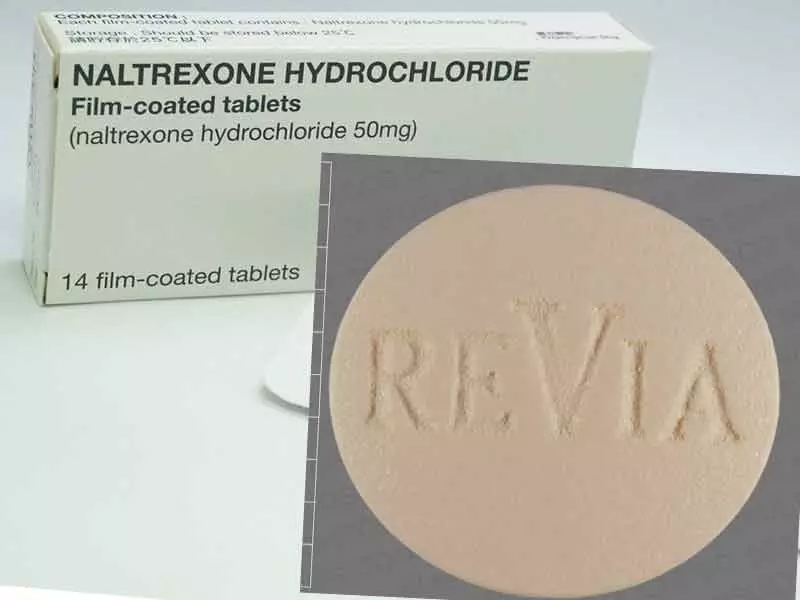Revia

Form of the drug
Pills.
!banner!
Composition
One pill contains Naltrexone hydrochloride — 50 mg.
Packaging
10 pills.
Pharmacologic effect
Revia competitively blocks the binding of agonists or displaces them from opiate receptors. It reduces or removes the symptoms caused by intravenous administration of opiates. The greatest affinity is to the mu- and kappa- receptors.
Revia, indications for use
- Prevention of the pharmacological effects of exogenous opioids and maintenance of the opioid-free status in patients with opioid dependence.
- Complex treatment of alcohol dependence.
Contraindications
- Hypersensitivity (including naloxone)
- Positive test for the presence of opioids in the urine
- Taking opiates
- Abstinent syndrome
- Acute hepatitis
- Liver failure
- Pregnancy
- Breastfeeding (should be excluded at the time of treatment)
- Children's and teenagers' age (up to 18 years).
Dosing and Administration
Oral administration.
The drug is prescribed only after the relief of the withdrawal syndrome and after preliminary detoxification.
The use of Revia is started in specialized drug treatment departments 7-10 days after the last taking of opioid drugs. Subsequently, the patient must be under strict medical supervision; positive attitude to the treatment of drug addiction is necessary in the patient.
Treatment of alcoholism: take the medication by mouth; 50 mg once a day; a 12-week course of treatment prevents relapses for 6 months (the success of treatment depends on the patient's compliance in following these directions).
Treatment of drug dependence can be started only after 7-10 days abstinence from using opioids confirmed by a provocative test and urine analysis for the content of opioids. The patient should have no signs of withdrawal syndrome. Treatment should not be started until the provocative trial with intravenous injection of 0.5 mg of naloxone is negative. The initial dose is 25 mg; the patient's condition should be supervised for 1 hour; in the absence of withdrawal syndrome, 50 mg once a day can be prescribed; this dose blocks 25 mg of heroin administered intravenously. Alternative treatment schemes are as follows:
- 50 mg every weekday and 100 mg on a Saturday
- 100 mg every other day
- 150 mg in 2 days
- 100 mg (on Monday), 100 mg (on Wednesday) and 150 mg (on Friday). It should be taken into account that the use of these schemes increases the risk of hepatotoxicity. The course of treatment is determined individually.
Application in pregnancy and lactation
Contraindicated.
Side effects
In the digestive system: rarely – increased appetite, dry mouth, flatulence, aggravation of symptoms of hemorrhoids, erosive and ulcerative lesions of the gastrointestinal tract, abdominal pain, increased activity of "liver enzymes".
In the nervous system and the sense organs: more often, an unusual tiredness. Rarely, the vagueness of visual perception, confusion of consciousness, hallucinations, depression of the central nervous system, ringing and feeling of stuffiness in the ears, pain and burning sensation in the eyes, photophobia, irritability, drowsiness, disorientation in time and space.
In the respiratory system: rarely – hoarseness, nasal congestion (hyperemia of the vessels in the nasal cavity), sneezing, shortness of breath, dryness in the throat, increased separation of mucous sputum, sinusitis.
In the cardiovascular system: rarely – chest pain; non-specific ECG changes.
In the genitourinary system: discomfort with urination, increased frequency of urination.
Allergic reactions: less often – skin rash. Rarely – hyperthermia, itchy skin, increased secretion of sebaceous glands.
Other reactions: rarely, thirst, increase or loss of body weight, pain in the groin area, enlarged lymph nodes, lymphocytosis. In one case, the development of idiopathic thrombocytopenic purpura against the background of preliminary sensitization to the drug is described.
Opioid withdrawal syndrome: abdominal pain, epigastric cramps, anxiety, nervousness, fatigue, irritability, diarrhea, tachycardia, hyperthermia, rhinorrhea, sneezing, goosebumps, sweating, yawning, arthralgia, myalgia, anorexia, nausea and/or vomiting, tremors, general weakness.
Also see Naltrexone Side Effects.
Special instructions
Prior to use, subclinical liver failure should be excluded; during treatment, the level of transaminases should be controlled periodically; combining with drugs that have hepatotoxic properties is prohibited.
To prevent the development of acute withdrawal symptoms, patients should stop taking opioids and drugs containing them at least 7-10 days before treatment; be sure to identify opioids in the urine and conduct a provocative test with naloxone; if these requirements are not complied with, withdrawal symptoms may appear 5 minutes after taking the drug and continue for 48 hours.
Revia should be cancelled no less than 48 hours before surgery which requires the use of opioid analgesics.
If an emergency analgesia is required, caution is prescribed for opioids in an increased dosage (to overcome antagonism), since respiratory depression will be deeper and more prolonged.
A persistent decrease in appetite and progressive weight loss require discontinuation of therapy.
Ineffective in the treatment of cocaine dependence as well as non-opioid drug dependence.
Patients should be warned that:
When seeking medical help, they are obliged to inform health professionals about treatment with Revia.
In case of pain in the abdomen, darkening of the urine, yellowing of the sclera, it is necessary to stop taking the medicine and consult a doctor.
With independent use of heroin and other drugs in small doses, there will be no effect from their use, and further increase of the dose of narcotics will lead to a fatal outcome (respiratory failure).
Drug Interactions
Increases (mutually) the risk of liver damage when combined with hepatotoxic drugs.
Lethargy or increased sleepiness is also possible when combined with thioridazine.
Reduces the effectiveness of medicines containing opioids (antitussive drugs, analgesics).
Accelerates the appearance of symptoms of "withdrawal syndrome" against the background of drug addiction (symptoms can appear within 5 minutes after drug administration and continue for 48 hours; they are characterized by persistence and difficulty in eliminating them).
Check the interaction of other drugs with Revia!
Storage conditions
Keep in dry and dark place at a temperature of no higher than 25° C.
Shelf life
See on the packaging.